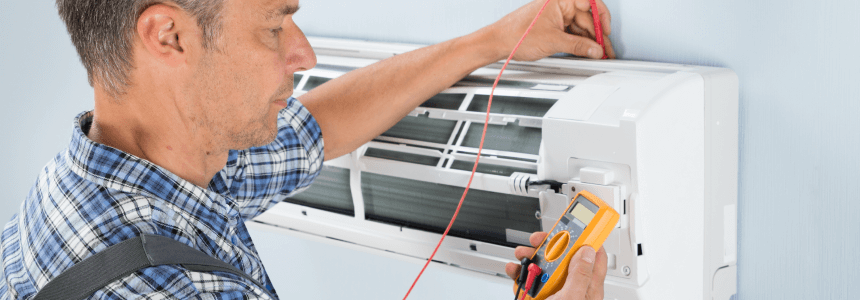
Contemplating coverage?
Subscribe to receive our emails & get
$200 OFF!
Have questions?
Call us: (833) 544-8273


Written By Rachel Cherem
When the summer heat rolls in and your AC starts blowing warm air, panic can set in fast. You might wonder: Do I need to call a technician or can I handle recharging the AC myself? For homeowners eager to save money and stay cool, this guide walks you through what you can and can’t safely do when it comes to recharging your AC without professional help.
Understanding the process is key to avoiding costly mistakes. While a full refrigerant recharge usually requires a licensed technician, there are proactive steps you can take to maintain your system and troubleshoot minor issues on your own before shelling out serious cash to replace your whole system.
Recharging an air conditioning unit refers to adding refrigerant to your system to restore its cooling capacity. Your AC relies on a specific amount of refrigerant to function properly. If the level drops due to a leak or other issue, the system can’t absorb and release heat efficiently, leading to warm air or inefficient cooling.
However, it’s important to know that refrigerant doesn’t get “used up” like fuel. If your system is low, it likely has a leak that must be addressed before any recharge is performed. Simply adding more refrigerant without fixing the leak can damage your system and worsen the issue.
Here’s the reality: most residential AC systems use refrigerants like R-410A or R-22, which are regulated by the Environmental Protection Agency (EPA). Handling these substances without the proper certification is not only illegal—it’s also potentially dangerous. Improper recharging can lead to compressor failure, poor performance, and even refrigerant poisoning.
That said, while recharging AC itself should be left to professionals, there are plenty of safe, legal, and effective maintenance steps you can take to support your system and determine when a recharge might be necessary.
Before you even consider recharging your AC, it’s important to know the signs of low refrigerant. Keep an eye out for:
If you notice any of these red flags, it’s time to investigate further.
One of the most common culprits behind reduced cooling is a dirty air filter. When airflow is restricted, the evaporator coil can freeze up, mimicking the symptoms of low refrigerant. Replace disposable filters monthly during peak use or clean reusable ones according to manufacturer guidelines.
Your outdoor unit can get clogged with dirt, leaves, and debris. Shut off power to the unit, then use a garden hose (not a pressure washer) to gently rinse the coils. Clean fins with a soft brush and straighten any that are bent using a fin comb.
If you spot ice forming on the indoor coil or refrigerant lines, turn off your AC and let it thaw. Run the system in fan-only mode for an hour or two. If the freezing recurs, that’s a strong indicator of low refrigerant or airflow issues.
Sometimes the issue is as simple as incorrect settings or a malfunctioning thermostat. Make sure it’s set to "cool" and the temperature is lower than the current room temp. Consider replacing old thermostat batteries or upgrading to a smart thermostat for better control.
While automotive-style AC recharge kits may be tempting, they are not designed for home systems. These kits often come with pressure gauges that are not accurate enough for residential units, and improper use can:
It’s also worth noting that many home warranties become void if you attempt to recharge the system yourself.
If you’ve gone through the checklist and your system still isn’t cooling properly, it’s time to contact a professional. A licensed HVAC technician can:
Recharging AC the right way involves more than just topping off fluid—it’s a detailed process that should be handled with care and technical expertise.
Keeping your system running efficiently over the long haul means staying on top of regular maintenance. Here are a few habits to adopt:
While you can’t legally recharge your AC on your own, there’s a lot you can do to maintain your system like a pro. Staying on top of routine care not only helps your AC last longer but can also delay the need for major repairs.
At Liberty Home Guard, we believe in empowering homeowners with the knowledge they need to make smart, safe decisions. Whether you’re troubleshooting cooling issues or planning ahead for next summer, explore our robust home warranty coverage to stay protected and cool all year long.
No. Most home AC units use refrigerants regulated by the EPA, and handling them without certification is illegal and unsafe.
Warm air from vents, longer cooling cycles, higher energy bills, ice on coils or lines, and hissing/bubbling noises near the unit.
No. Automotive-style kits can damage your system, add contaminants, and may void your home warranty.
Clean or replace air filters, clear debris from the outdoor condenser, check thermostat settings, and look for ice buildup.
Low refrigerant means there’s likely a leak that must be fixed before recharging to avoid further damage.
Stay Ahead of Potential
Home Mishaps!
Subscribe to our Liberty Home Guard Newsletter and gain access to exclusive content that ensures your peace of mind.